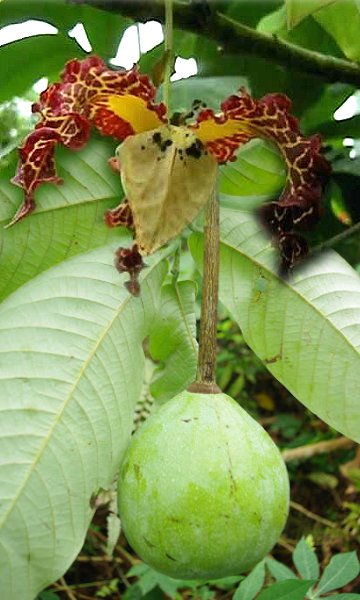
|
|
Calabash nutmeg
(Monodora myristica). Flowers and fruits.
|
Calabash nutmeg - Monodora myristica
Monodora myristica, the calabash nutmeg, is a tropical tree of the family Annonaceae or custard apple family of flowering plants. It is native to Angola, Benin, Cameroon, the Central African Republic, the Democratic Republic of the Congo, Equatorial Guinea, Gabon, Ghana, Guinea-Bissau, Ivory Coast, Kenya, Liberia, Nigeria, the Republic of the Congo, Sierra Leone, Sudan, Tanzania, Togo and Uganda. In former times, its seeds were widely sold as an inexpensive nutmeg substitute. This is now less common outside its region of production.[3] Other names of calabash nutmeg include Jamaican nutmeg, African nutmeg, ehuru, ariwo, awerewa, ehiri, airama, African orchid nutmeg, muscadier de Calabash and lubushi.
Calabash nutmeg forms a large branching tree with a grey-barked trunk and can reach 35 m high and 2 m in diameter
in nature. It has a clear trunk and branches horizontally. It has large leaves (35 cm long and 18 cm wide) at the end of its branches. The leaves are purple at first but turn a smooth deep green on the upper side with paler green underneath. They are prominently veined and the petiole (leaf stem) is purplish.
The flower appears at the base of new shoots and is singular, pendant, large and fragrant. The pedicel bears a leaf-like bract and can reach 20 cm in length. The flower’s sepals are red-spotted, crisped and 2.5 cm long. The corolla is formed of six petals of which the three outer reach a length of 10 cm and show curled margins and red, green and yellow spots. The three inner petals are almost triangular and form a white-yellowish cone which on the outside is red-spotted and green on the inside. The flower’s stigmas become receptive before its stamens mature and shed their pollen (protogynous). Its pollen is shed as permanent tetrads. The flower is pollinated by insects.
In the wild, this species is pollinated by beetles.
The flowers are followed by large woody fruits filled with brown seeds embedded in aromatic pulp.
The fruit is a berry of 20 cm diameter and is smooth, green and spherical and becomes woody. It is attached to a long stalk which is up to 60 cm long. Inside the fruit the numerous oblongoid, pale brown, 1.5 cm long seeds are surrounded by a whitish fragrant pulp. The seeds contain 5-9% of a colourless essential oil.
There are around 14 species of Monodora (meaning one gift, alluding to its solitary fruit) in tropical Africa.
The calabash nutmeg tree grows naturally in evergreen forests from Liberia to Nigeria and Cameroon, Ghana, Angola and also Uganda and west Kenya.[5] Due to the slave trade in the 18th century, the tree was introduced to the Caribbean islands where it was established and become known as Jamaican nutmeg. In 1897, Monodora myristica was introduced to Bogor Botanical Gardens, Indonesia, where the trees flower on a regular basis but no fruit could yet be collected. Due to its large and orchid-like flowers, the tree is also grown as an ornamental.
The odour and taste of the Monodora myristica seed is similar to nutmeg and it is used as a popular spice in the West African cuisine. The fruits are collected from wild trees and the seeds are dried and sold whole or ground to be used in stews, soups, cakes and desserts.
For medicinal purposes they are used as stimulants, stomachic, for headaches, sores and also as insect repellent.
The aromatic seeds are antiemetic, aperient, stimulant, stomachic and tonic.
They are used as a stimulating addition to medicines. Ground to a powder they may be taken to treat digestive problems and relieve constipation.
Applied externally in the form of a powder, or made up into an oily pomade, the seed can be applied to sores, especially those caused by the guinea-worm.
It is also applied to rid the body of fleas and lice. The seeds are chewed up and applied to the forehead to relieve headaches and migraine.
The seeds smell like nutmeg and are used to make aromatic necklaces and rosaries.
In medicine, the bark is used in treatments of stomach-aches, febrile pains, eye diseases and haemorrhoids.
The bark is used to treat haemorrhoids, stomach-ache and febrile pains.
The bark is used in a vapour-bath as a defatigant and to relieve febrile lumbago.
The juice expressed from the bark is used to paint over itch Combined with the bark of Monodora tenuifolia a lotion is prepared for use in various eye-troubles.
Monodora myristica timber. The white or greyish wood is hard, somewhat tough does not split well and is easy to work.
It is suitable for carpentry, turnery, joinery and also used for making walking sticks.
Source:
https://en.wikipedia.org/wiki/Monodora_myristica
http://tropical.theferns.info/viewtropical.php?id=Monodora+myristica
http://www.plantsoftheworldonline.org/taxon/urn:lsid:ipni.org:names:74141-1
